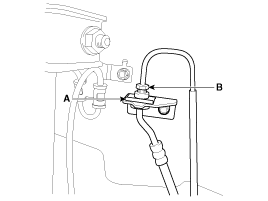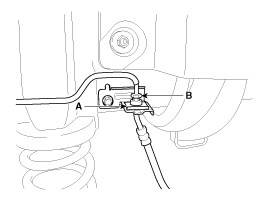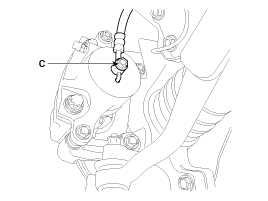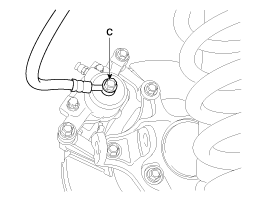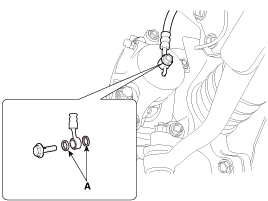Kia Optima Hybrid: AHB(Active Hydraulic Boost) System / Brake Line Repair procedures
Kia Optima Hybrid (TF HEV) 2016-2020 Service Manual / Brake System / AHB(Active Hydraulic Boost) System / Brake Line Repair procedures
| Removal |
| 1. |
Disconnect the brake fiuid level switch connector, and remove the reservoir cap. |
| 2. |
Remove the brake fluid from the master cylinder reservior with a syringe.
|
| 3. |
Remove the wheel & tire. |
| 4. |
Remove the brake hose clip (A).
Front
Rear
|
| 5. |
Disconnect the brake tube by loosening the tube flare nut (B).
|
| 6. |
Disconnect the brake hose from the brake caliper by loosening the bolt (C).
Front
Rear
|
| Inspection |
| 1. |
Check the brake tubes for cracks, crimps and corrosion. |
| 2. |
Check the brake hoses for cracks, damage and fluid leakage. |
| 3. |
Check the brake tube flare nuts for damage and fluid leakage. |
| 4. |
Check brake hose mounting bracket for crack or deformation. |
| Installation |
| 1. |
Installation is the reverse of removal.
|
| 2. |
After installation, bleed the brake system.
(Refer to Brake system bleeding) |
| 3. |
Check the spilled brake oil. |
 Brake Line Components and Components Location
Brake Line Components and Components Location
Components ...
 Brake Pedal Components and Components Location
Brake Pedal Components and Components Location
Components 1. Brake pedal stroke sensor2. Stop lamp switch3. Brake pedal ...
Other information:
Kia Optima Hybrid (TF HEV) 2016-2020 Service Manual: Heater Unit Repair procedures
Replacement 1. Disconnect the negative (-) battery terminal. 2. Recover the refrigerant with a recovery/ recycling/ charging station. 1) Do not use the same A/C recovery / charging station as conventional belt-driven compressors. 2) Since the electric compressor uses high-voltage, you should ...
Kia Optima Hybrid (TF HEV) 2016-2020 Service Manual: Description and Operation
Description The Vehicle Information System is a Telematics service that ensures comfortable and enjoyable driving by providing safety, security, and vehicle diagnostic information, with the option of using your smartphone. The term "Telematics" is a combination of telecommunication and ...
© 2025 Copyright www.koptimatfhev.com


